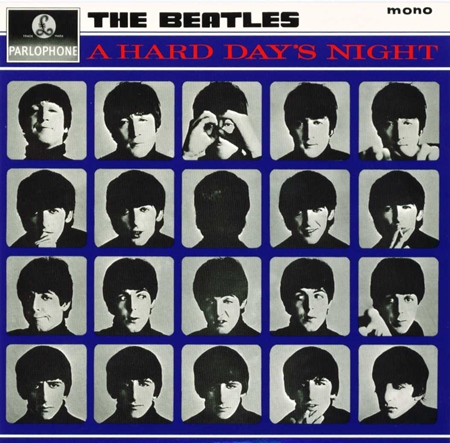
The Beatles: A Hard Day’s Night (Parlophone)
Released in July 1964.
Side 1:
1. A Hard Day’s Night
2. I Should Have Known Better
3. If I Fell
4. I’m Happy Just To Dance With You
5. And I Love Her
6. Tell Me Why
7. Can’t Buy Me Love
Side 2:
1. Any Time At All
2. I’ll Cry Instead
3. Things We Said Today
4. When I Get Home
5. You Can’t Do That
6. I’ll Be Back
(All songs composed by John Lennon and Paul McCartney)
Lineup:
John Lennon: vocals, electric guitar, acoustic guitar, harmonica, tambourine
Paul McCartney: vocals, bass guitar, piano, cowbell
George Harrison: vocals, electric guitar, acoustic guitar, claves
Ringo Starr: drums, conga, bongos, tambourine
George Martin: piano
By the summer of ‘64 they were the kings of the whole wide world, but when the famous Rickenbacker chord kick-started the song, the LP and the movie “A Hard Day’s Night”, The Beatles turned into gods. That chiming Fadd9 is where the myths and wonders of the 60’s really begins. Wham!
The recording itself is extremely exciting and way beyond its time. The noise is overwhelming, intoxicating, its hard, metallic and chiming sound has an urgent forward push, there’s no time for breathing, an effect strengthened by the vocal overlaps – Paul taking over the baton in each bridge long before Lennon’s voice has faded. The drums adds to the song’s majestetic power while the percussion elements makes the whole thing simmer.
When “A Hard Day’s Night” (the song) checks out with Harrison’s fading Rickenbacker you feel exhausted and ready for a cigarette, like you just had sex with the girl of your dreams.
I guess it is hard for those who weren’t there to imagine how one’s first encounter with this wonder of a record felt in July 1964. Music had never sounded like this before. Me, I walked on air, madly excited, I thought anything was possible. And it was.
In Norway we never got a chance to see the Beatles in flesh and blood. Until the “A Hard Day’s Night”-movie came along all we had were the grainy black and white photos in papers like New Musical Express and the colourful fan pics in magazines like Fabulous and the glossy Pop Pics.
The movie was a revelation, the four characters not only moved across the canvas but popped out of it , they were in the same room as us, alive as you and me. The cinema exploded in deafening cascades of screaming girls and pounding teenage feet. It was like nothing I have seen or heard in my whole life. The experience filled me with a strange pride and shudders of happiness.
The Beatles. The musketeers. Our heroes. They talked, they laughed, and most important: They revolted. Against managers, TV producers, journalists, elderly passengers on the train. Against anything and anyone who tried to cage them in. “A Hard Day’s Night” was a wonderous cry of freedom that spoke to the baby boomers like nothing or no-one, not even Elvis, had ever done before. It was so easy to relate to.
Hell, parents hated this stuff, they hated the music, they hated the haircuts. And so did the teachers at school. The Beatles cracked the generation gap wide open. It was an awakening. We didn’t know sh*t about politics, we were too young for that, but the sense of togetherness against the establishment was joyous. A special kind of generation awareness was born, taken for granted today, but before 1964 youth culture did not excist. Suddenly you were not alone, there was an “us” and a “them”.
We watched that movie with eyes that were defenitely not the same eyes that had watched the Disney-flick “The Sword In the Stone”. We were young freemasons in the company of our mop top Grand Masters, taking it all in, every detail, the way they walked,they way they sat, the way they stood, the way they talked – and most of all, the John Lennon mimicry, our secret signs. Eyes sparkling in awe, cameras zooming in and out capturing The Beatles as they delivered their comedy act or sang and played music unlike anything anyone had ever created before. Boy did we enjoy it.
Shooting the movie in monochrome was a stroke of genius. “A Hard Day’s Night” is an equally strong argument for the superiority of the black and white movie as “Casablanca” and “Citizen Kane.”
The cover art of the album sleeve is one of rock’s most powerful. Five smail black and white portraits of each beatle laid out like a proof sheet. Very elegant, very tasteful. And because each portrait is different, the faces become alive, like moving pictures. You can read them like you read a comic book.
The US version of the soundtrack album was released in June, one full month earlier than in Europe. But it wasn’t the same album as it contained only eight songs. The rest were George Martin instrumentals. The British version was a much more attractive package sporting 13 beatle songs and no Martin plodding.
It was the first and only time a Beatles album contained only Lennon/McCartney originals. It is also the only original Beatles-album besides “Let It Be” with no Ringo vocal on it. He got to sing “Matchbox”during the sessions, but as that was a Carl Perkins cover it did not fit in. So “Matchbox” was relegated to the “Long Tall Sally” EP.
Almost all of the 13 album cuts are classy tunes. High-spirited, saturated in the silvery chiming of the 12 string Rickenbacker (Roger McGuinn built an entire career on the guitar sound of the “A Hard Day’s Night” movie), lush vocal harmonies, the voices so tightly interwoven with the lead vocal that they almost became one, the redemptive use of acoustic guitars that give the sharp and often hard hitting songs an airy feel.
People tend to forget that The Beatles were a guitar band, and a tight and sophisticated little combo to boot. I hand you the “A Hard Day’s Night” album as exhibit 1.
Lennon’s voice dominates the proceedings. He also wrote most of the songs, including the title track itself, the lovely harmonica driven “I Should Have Known Better” (so in love with its own verses that it simply skips any attempt at refrains, providing very strong middle eight instead, though), the quite advanced and dazzlingly beautiful “If I Fell” (John and Paul’s two-part singing here is simply divine), the on the verge of rupture over-produced “Tell Me Why” which swings madly, the country-ballad “I’ll Cry Instead”, the marvellous “Any Time At All” (could and should have been a single), the painfully hard “You Can’t Do That” and the acoustic album-closer “I’ll Be Back” (another wonderful round of multi-layered John and Paul vocal harmonies).
It is undoubtedly John’s LP, although Paul’s contribution to his songs should not be underestimated. If Paul delivers few songs of his own, the ones he does offer are as good as anything by his patner. “Things We Said Today” with its blistering triple attack on the Am chord and its dark, haunted lyrics, is up there among The Beatles’ best recordings – it was actually marked for double A-side status with “A Hard Day’s Night”, promo copies were pressed. “And I Love Her” is sensitive and exceptionally beautiful and includes a lovely acoustic solo from Harrison. And the jazzy swinging “Can’t Buy Me Love” had already proven itself, being a huge hit in early spring of 1964 and also the first single A-side written by a Beatle alone.
“A Hard Day’s Night” might not be the best Beatles- album, but it’s at least top 3 and definitely the most perfect of them all. Every time I put it on, the music lifts me into the bright, cheerful optimism of 1964. Nothing beats these 30 minutes in their company. The movie? I am not ashamed to admit that I have seen it more than one hundred times. Actually, the last time I saw it was three weeks ago!
First published in Pattaya Mail on April 4, 2013.
 |
 |
 |





